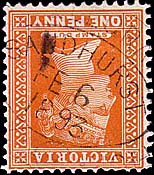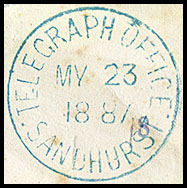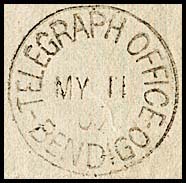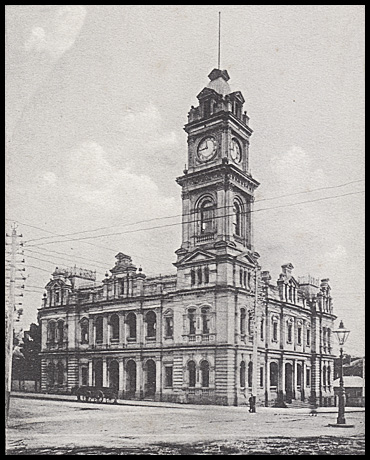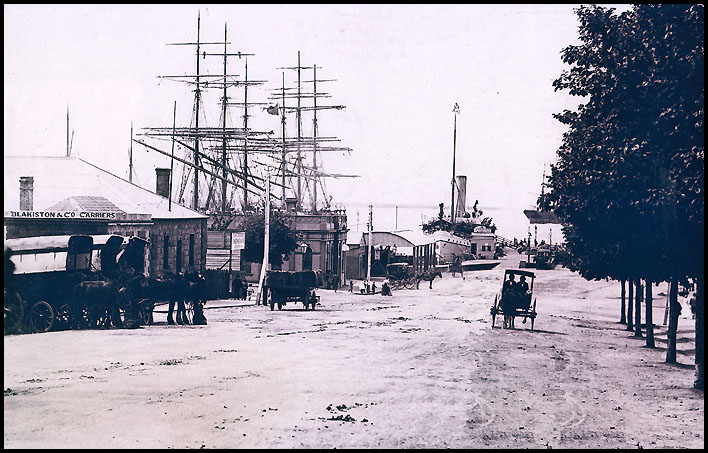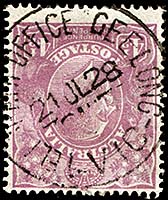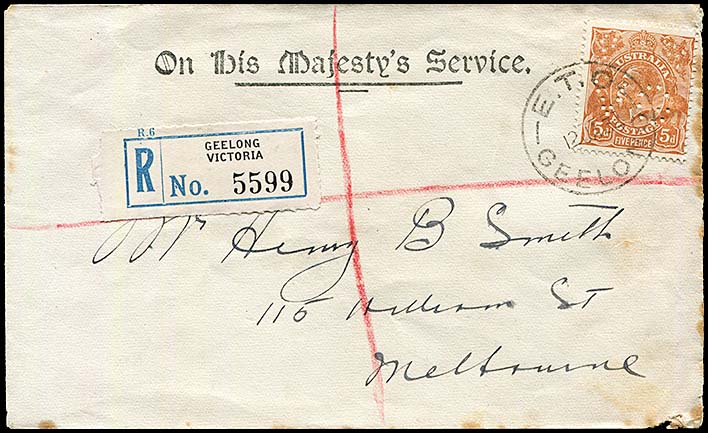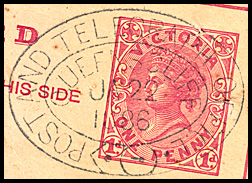Telegraph Offices on the first lines - 1854 to 1856.
- Home, index, site details
- Australia 1901-1988
- New South Wales
- Overview of NSW
- Telegraph lines
- Telegraph Offices
- Date stamps
- Forms
- Envelopes
- Rates
- Stamps
- Queensland
- Overview of Qld
- Telegraph lines
- Telegraph offices
- Date stamps
- Forms
- Envelopes
- Rates
- Stamps
- South Australia
- Overview of SA
- Telegraph lines
- Telegraph Offices
- Date stamps
- Forms
- Envelopes
- Rates
- Stamps
- Tasmania
- Overview of Tasmania
- General developments
- Reports
- Organisation
- Telegraph lines
- Telegraph Offices
- Date stamps
- Railway lines
- Forms
- Envelopes
- Rates
- Stamps
- Overview of Tasmania
- Victoria
- Overview of Vic.
- Telegraph lines
- Telegraph offices
- Date stamps
- Forms
- Envelopes
- Rates
- Stamps
- Ephemera
- Western Australia
- Overview of WA
- Telegraph lines
- Telegraph Offices
- Date stamps
- Forms
- Envelopes
- Rates
- Stamps
The first Telegraph Offices on the first line which are described here are:
- Ballarat;
- Bendigo (Sandhurst);
- Geelong;
- Port Melbourne (Sandridge);
- Queenscliff;
- Williamstown.
Ballarat had two formats for its Belt & Buckle date stamps:
|
Provenance: |
On a delivery envelope of type VC-EO-8. |
Provenance: Hugh Freeman, Johnstone. |
|
|
| At least four (and possibly five) designs for a TELEGRAPH OFFICE date stamp were used between 1905 and 1982. They can be easily distinguished from the wording at the top and the diameter. | ||
|
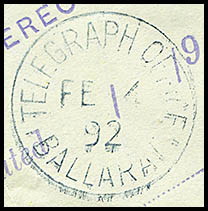
4 February 1892. Used on VC-DO-13. |
|
|
 11 October 1911. Used on VI-DO-3Da. |
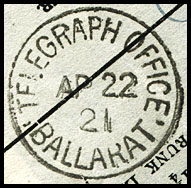 22 April 1921. Used on a Telephone account. |
 10 August 1926. On a pair of £2 purple-black & rose 3rd watermark Kangaroo on map. |
||
|
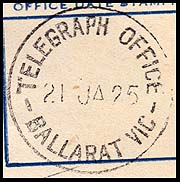 21 January 1925. Used on AB-DO-3Ba. |
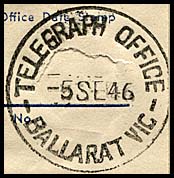 5 September 1946. Used on AW-DO-10Aa (44). |
|
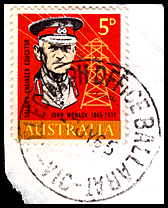 9 July 1965. |
|
|
||
|
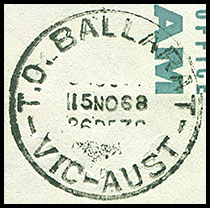 15 November 1968. (earliest recorded date) . |
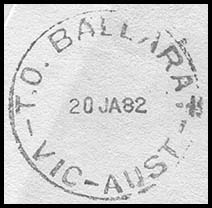 20 January 1982. |
A postal slogan advertising HAPPY THOUGHTS! CHRISTMAS AND NEW YEAR GREETINGS BY TELEGRAM was used at Ballarat during the December 1955/January 1956 period.
|
In August there was a major break-out from the gaol. The Ballarat Star claimed "that the cost to the state of the late Ballarat Gaol breaking has been not less than £2,000. Of this amount it has been estimated that £500 worth of telegraphing was done in connection with the affair". There appears to have been a Telegraph Office at the Ballarat Race Course at some time - open only on race days. The Argus of 24 March 1876 reported: "The opening meeting of the newly-formed Victoria Amateur Turf Club takes place today on the Ballarat course. There are six events, of which the principal is the Victoria Gold Cup Handicap Steeplechase of three miles ... There will be one train soon after noon from Ballarat West to the course and one back after the last race. The telegraph office will be open on the course during the day". Nothing else is known about this Office. It may be a precursor of the T.O. opened at the Ballarat Miners' Racecourse between about 1933 and 1938. |
|
The Geelong Advertiser of 5 June 1874 carried the following story:
|
|
 |
Postcard sent from Dulwich Hill, Sydney on 1 April 1907 to Mr. J. (Bert) Brown who was the Telegraph Operator at Ballarat. |
| Bendigo (Sandhurst).
The Telegraph Office opened in January 1857. On 7 January, the Argus reported that "some parties working at the back of the new telegraph office, opposite the Argus office, yesterday found a nugget of 27 lbs. weight ... it strikes us that those who have gone to Dunolly and elsewhere had better have remained upon old Bendigo". Almost immediately, questions were asked in the Legislative Assembly about the difficulties of communication. On 28 January in the Legislative Assembly "the attention of the Commissioner of Customs was called to the fact of the telegraphic communication with Sandhurst being broken, and explained that it arose from some of the posts having been carried away by bullock teams". The Sandhurst Post Office was renamed Bendigo about June 1891.
|
|
||
 Postal date stamp on a Telegram delivery envelope (VC-DO-2B). |
|||
There are three formats for Telegraph datestamps for Bendigo:
|
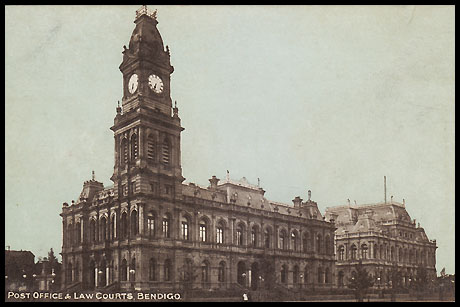 Bendigo Post & Telegraph Office with the Law Courts at the right - about 1905. |
|
Provenance: |
|
| 2. Bendigo: 1 hole in black.
|
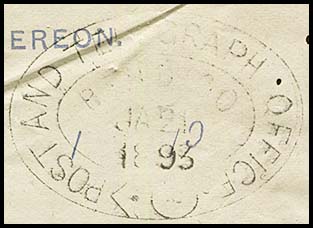 21 January 1893. Used on VC-DO-14. |
|
| TELEGRAPH OFFICE SANDHURST. Date in two lines and has separation dots.
|
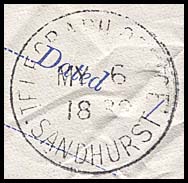 6 May 1882. Used on VC-DO-10. |
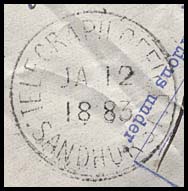 12 January 1883. Used on VC-DO-10. |
 27 August 1888. 27 August 1888. |
||
|
Used on VC-DO-11C. |
| TELEGRAPH OFFICE BENDIGO (steel).
There were four formats for this heading in steel which can be easily distinguished from the wording at the top and the diameter. |
|||
|
Used on VC-DO-15B. |
Used on VI-DO-2A.
|
|
|
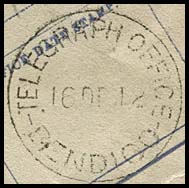 16 December 1912. Used on VI-DO-3Da. |
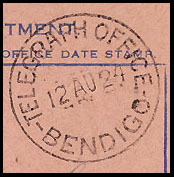 12 August 1924. Used on AB-DU-3B. . |
|
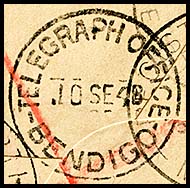 10 September 1948. Used on the reverse side of a registered 2½ PSE to Perth with two other cancellations on the embossed image and additional stamps. |
|||
Not included in WWW. Also used on some now scarce philatelic covers on 12 November 1955 for the 2nd Philatelic Conference of the Victorian Philatelic Council. |
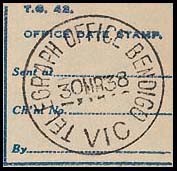 30 March 1938. |
||
|
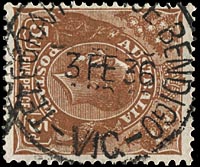 3 February 1936. |
 20 July 1959. |
|
Only one slogan date stamp was used at Bendigo to advertise the Telegraphic service.
|
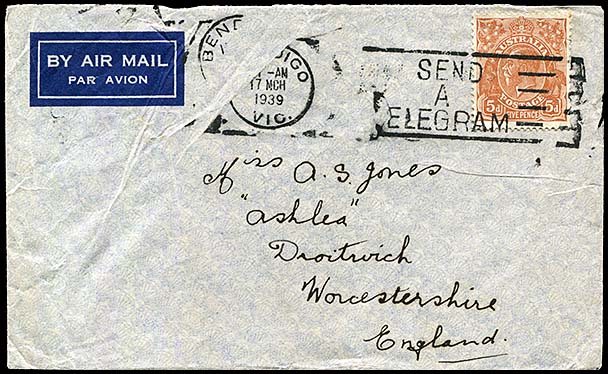 17 March 1939. |
Telegraph Offices were also opened in three locations around Bendigo:
|
 A straight line Bendigo handstamp was also issued for use with telegrams (see VI-DO-1B). |
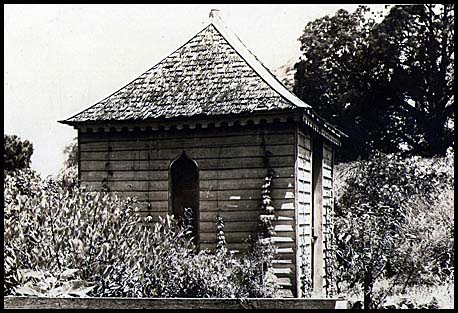 The first Telegraph Office in Geelong - probably the temporary office. |
 The Old Telegraph Station at 83 Ryrie Street - as from July 1857. (Photographer: John Collins). Source: State Library of Victoria SLV H96 210449. |
The Argus, of 24 January 1855 (p.4) ran the following story from the Geelong Correspondent: "As the grand principle of the electric telegraph is rapidity of communication, I am at a loss to understand why the Geelong Telegraph Office has been placed beyond the pale of business entirely. Had some fool or evil-disposed person wished to ridicule the affair, or deprive the public of the vast benefits to be derived from the establishment, he could have taken no better step than the Government has done itself by placing the office outside the town, that is, at the corner of Bellerine and McKillop streets, about one mile from the centre of business. Just fancy the Melbourne office being erected at Collingwood and you will have some idea of the inconvenience we shall be afforded, from what you might expect yourselves in that case. The public should endeavor to have this ridiculous arrangement altered at once". The story is continued at length elsewhere. On 28 January 1857, in the Legislative Assembly, Mr. Childers, in reply to Mr, Fyfe, said it was the intention of the Government to change the site of the present telegraph station at Geelong but the new site had not been determined. He imagined, however, that it would be erected somewhere in the vicinity of the Post Office of that town. In February 1881, an advertisement for the auction of a property described the lot, in part, as being "a residence in McKillop Street, next door to the old telegraph office". In October 1887, questions were asked in the Legislative Assembly as to why telegrams delivered near Geelong attracted a 3/- charge. |
|
| Seven formats for date stamps were used at Geelong: | |
The first two issues were 1-hole and 2-hole BELT & BUCKLE date stamps - although the 1-hole format is a very recent discovery.
|
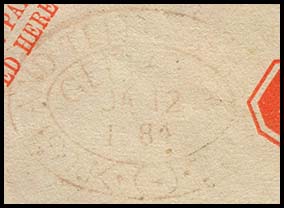 12 January 1884. Used on VC-EO-8. |
|
Characteristics:
|
|
|
Characteristics:
|
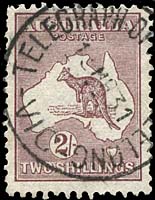 13 March 1931. |
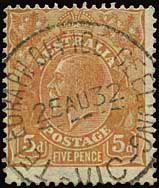 25 August 1932. |
 11 May 1940. Used on Mothers' Day form (AA-GM-39). |
 11 July 1957. |
Characteristics:
|
 23 May 1934. |
|
| This date stamp was also used in violet at the Fire Demonstration in March 1940. | 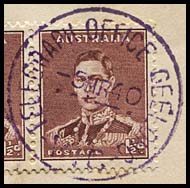 Detail from cover below. 5 March 1940. |
||
 |
|||
Characteristics:
|
 5 January 1963. (ERD - see Geelong). (see APO form AA-DO-13D). |
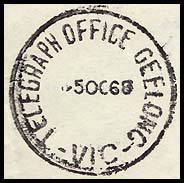 5 October 1968. |
Characteristics:
|
|
|
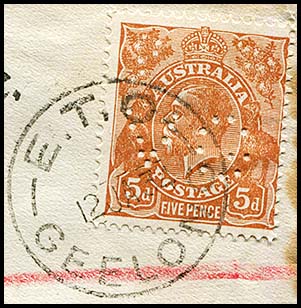 Detail of the above cover. |
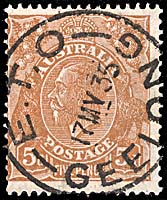 17 May 1935. |
|
| Postal date stamps used on telegrams: | 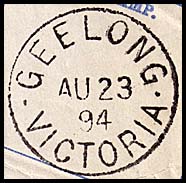 Geelong 23 August 1894. Postal date stamp used on telegram VC-DO-15B. Diameter: 26 mm. |
|
|
Telegraph Offices were also opened at four locations around Geelong:
|
|
|
|
The date stamp GEELONG FORD'S Works is known for:
|
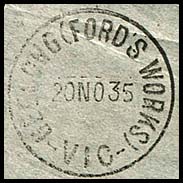 20 November 1935. |
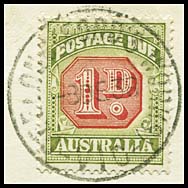 8 December 1938. |
|
|
|||
|
|||
Two postal slogans advertising:
were used at Geelong in December 1941 and in January 1942. |
|||
| Port Melbourne (Sandridge).
The Telegraph opened as Sandridge in July 1855 as part of the first telegraph line in Victoria. In 1884, the original name of Sandridge was changed to Port Melbourne.
|
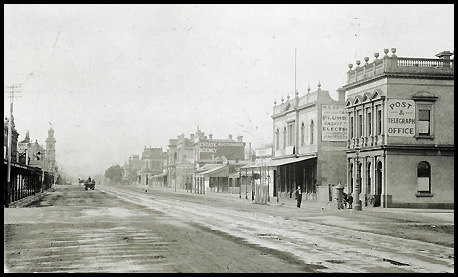 The Sandridge Post & Telegraph Office is at the far right. |
|
| Two date stamps were issued to Port Melbourne Telegraph Office for use with telegraphic business: | ||
|
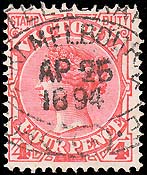 25 April 1894. (Latest recorded date). |
|
|
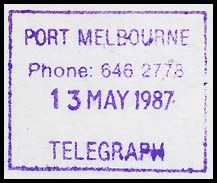 13 May 1987. |
|
| The usual postal date stamp was also used on telegrams: | 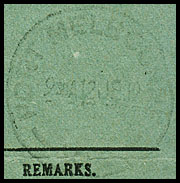 12 June 1919. Faint postal date stamp on |
|
| Queenscliff.
The Telegraph Office opened in January 1855. The telegraph posts to Geelong had been fixed in place in November 1954. The Post Office had opened as Shortland's Bluff on 1 May 1853 but changed name to Queenscliff in 1854. The contractor was Mr. G. W. Owen who also constructed the Camberwell-Lilydale telegraph line and ran for the Council in Traralgon in 1900. |
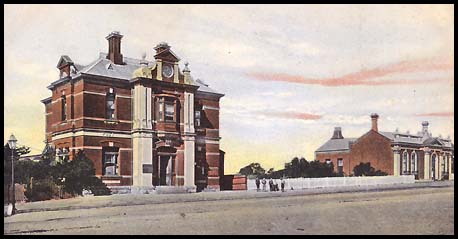 The Queenscliff(e) Post Office (left) and Free Library. |
It did not take long to capitalise on the presence of the Telegraph Office. From January 1855, the Argus was carrying advertisements similar to the following:
|
|
| A 1 hole Belt & Buckle date stamp was issued to Queenscliff.
Used in black: 22 January 1886 and 6 April 1894. Size: 27 × 38 mm (e = 0.70). Rated: not scarce. |
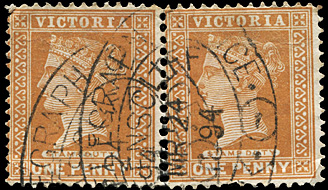 24 March 1894. |
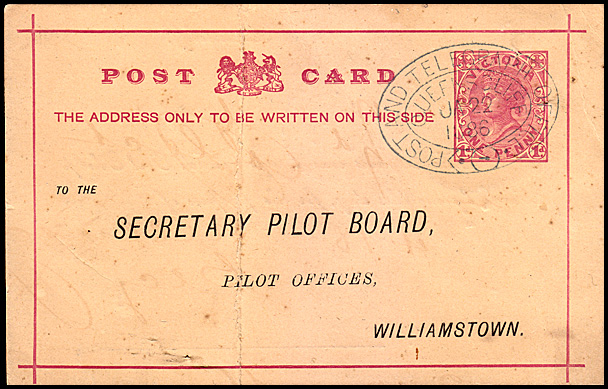 |
Used on a postcard to the Pilot Board reporting "the Mavis had been brought inside Port Philip Heads by me this day for the purpose of getting provisions". |
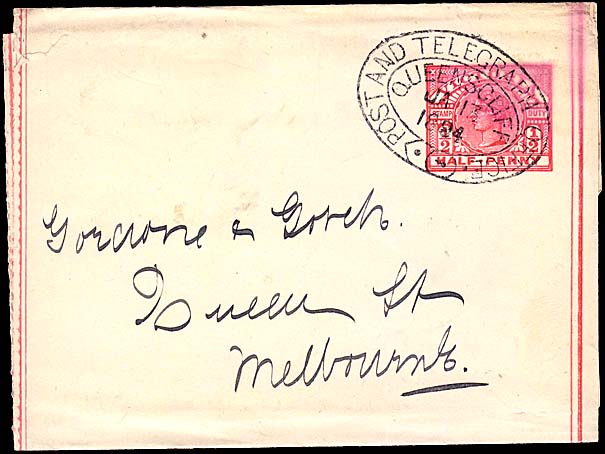 |
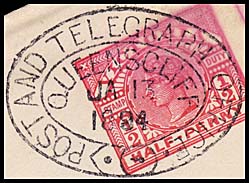 13 January 1894. Used on a wrapper to Gordon & Gotch. |
|
 Source: State Library of Victoria H2010 120/1. |
In 1923, Bob Kent was a Telegraph Messenger employed by the PMG Department.
Bob was assigned to the Queenscliff Telegraph Office. At that time, Bob was aged 14 years. |
The TELEGRAPH OFFICE.
|
1 hole Belt & Buckle date stamps were used at Williamstown:
|
 Used 11 March 1885. Provenance: Hugh Freeman, James Johnstone. |
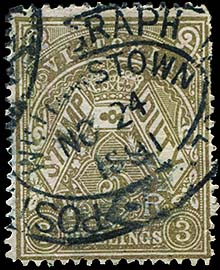 24 November 1891. Provenance: Hugh Freeman, James Johnstone. |
|
 14 December 1892. |
 29 March 1894. |
| 21 March 1889. Belt & Buckle 1 hole date stamp used in black on the postcard to The Advertiser shown below and the reverse side to the right. |
 Detail of the Belt& Buckle date stamp. |
 Reverse side of the postcard to the Advertiser. |
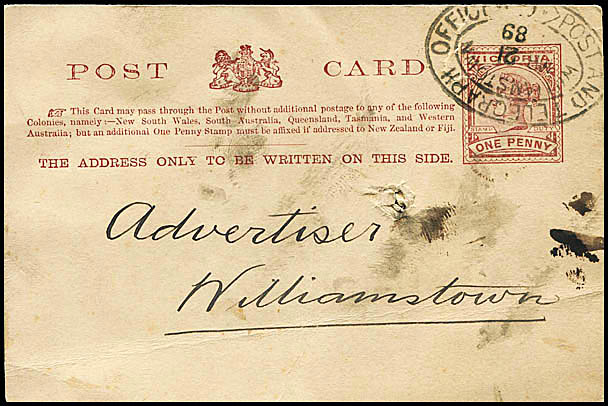 21 March 1889 Belt & Buckle date stamp on a postcard. |
||
A rubber TELEGRAPH date stamp (RRV1-T) was also used at the Telegraph Office.
|
 20 June 1942. Used on AB-GCF-39C. |
| Ordinary postal date stamps were also used on telegrams and delivery envelopes - especially after 12 June 1879 when the Post and Telegraphs Department issued an official instruction that all telegrams for delivery should be marked with a date stamp of the receiving office..
|
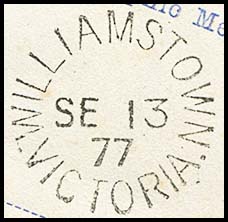 Williamstown unframed date stamp. 13 September 1877. Used on VC-DO-8B. Earliest recorded use of a date stamp on a Victorian telegram delivery form. |
| The time ball tower and lighthouse building were separate and slightly removed from the first Telegraph Office. On 13 May 1863, the Sydney Morning Herald reported: TIME-SIGNAL AT PORT PHILLIP HEADS. From the Government Gazette. It is hereby notified that, on and after the 1st May proximo, a time-signal will be given daily (Sundays excepted) by means of a black ball working on the topmast of the flagstaff at Shortland's Bluff. The signal will correspond to 1 o'clock p.m. mean time, as corrected at the Astronomical Observatory, Williamstown. The ball will be hoisted to the full height at five minutes before one, and will drop at one o'clock precisely. In the event of imperfection or incorrectness occurring on any occasion in giving the signal, the No. 2 flag pendant (Marryat's code) will be immediately shown and kept flying at the mast-head for fifteen minutes. Samuel Walker McGowan, |
||
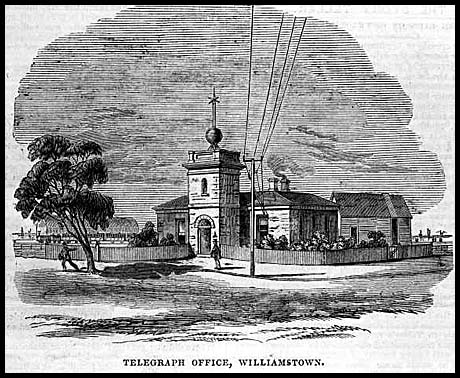 |
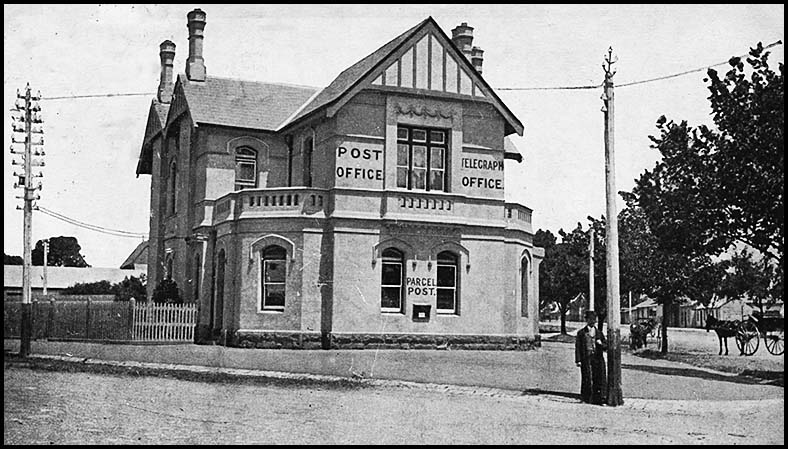 |
|
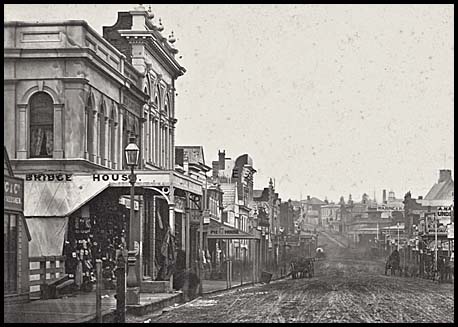
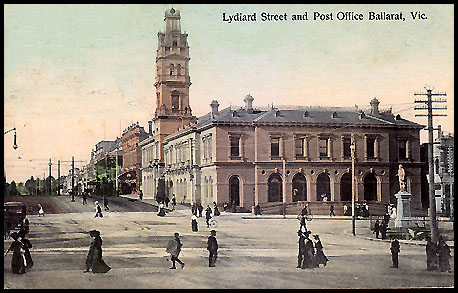
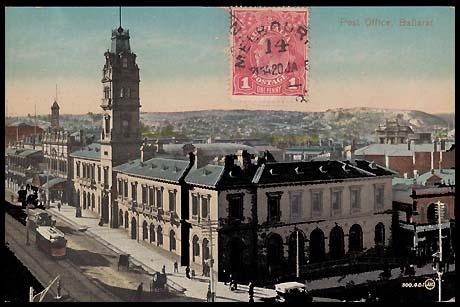
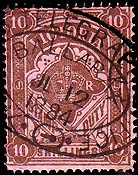
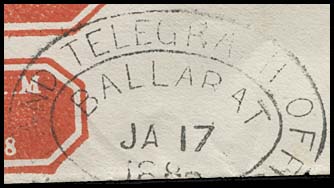
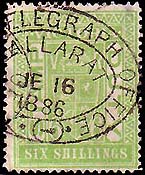
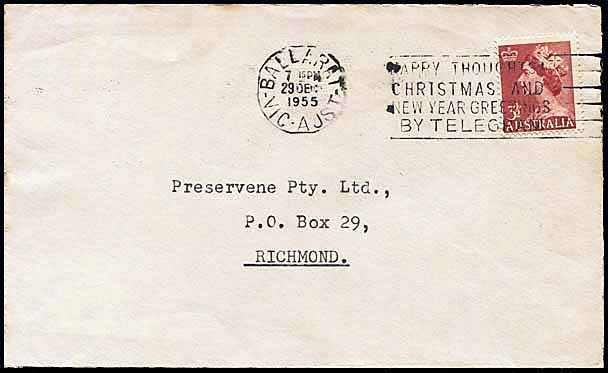
.jpg)
